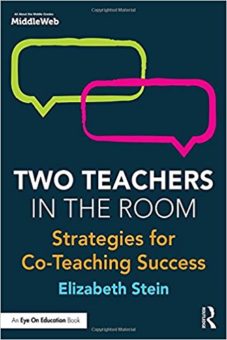The Essentials for Co-Teaching Success
Two Teachers in the Room: Strategies for Co-Teaching Success
By Elizabeth Stein
(Routledge/Eye On Education, 2018 – Learn more)
Teaching in the classroom has evolved over the last 16 years of my career. When I first started I never heard of a co-teaching assignment. Today, many of the classrooms in the school building involve co-teaching.
Two Teachers in the Room: Strategies for Co-Teaching Success by Elizabeth Stein explores how this works and what makes it work for everyone involved, especially the students.

The Focus of Co-teachers: Students
You might be thinking all that is great, but I have to work with another teacher in the room. This can be challenging, and I know first hand because I was asked to step in to cover a medical leave in a Grade K inclusion class in November. I am covering for the general education teacher.
According to Stein, “There is one main goal that can lead to success regardless of the teacher pairing and that is focusing on student success. One of the two co-teachers must have the attitude, ‘We will make it work – no matter what’.”
Elements of Successful Co-teaching
Building on this attitude, I especially liked Stein’s idea of the five areas that are used to build the components of success. These are vision, skills, incentives, resources and action plan. The reader is asked to use the traditional five W’s to think about each component in relationship to the classroom.
Sticking with the student success focus, I found Dr. Todd Rose’s work on the Universal Design for Learning as a stand-out point. His research has shown that the “normal” or “average” brain does not exist. He believes what does exist is learner variability: the fact that in any classroom-any grade-any subject-anywhere, there are learners with variable needs. (See this TEDx talk by Todd Rose for a good explanation of “variability” vs. “average.”)
Teachers should not be planning instruction as if children with disabilities, ESL, gifted and talented are a separate “type of learner.” They should observe how these learners blend with the natural variability that occurs anywhere learners are present. This is the basis of the UDL design for learning which is discussed in depth in Stein’s book.
Specially Designed Instruction
Stein also shares information about Specially Designed Instruction and advocates for the needs and requirements of special education students. The book focuses on several different co-teaching models and how important it is for co-teachers to “embrace a deep commitment” to a co-teaching relationship so students with special needs can make gains along side general education students.
For someone without special education training I found these different models to be very interesting. I have actually seen some of these models, and thinking back, I don’t believe I fully understood what the teachers were doing until I read this book.
The book also helps the uninitiated reader understand that every classroom does not come filled with students who are ready to learn. Stein discusses Maslow’s hierarchy of needs and offers reflection questions to connect it with classroom learning.
She helps readers understand Maslow’s explanation of how our environment, our desires, our connections, and relationships with others make up the first four levels of need. Our minds and our intellect control satisfaction at the highest level, according to Maslow. From here, Stein guides the reader to focus on mindful teaching and how this mindset can be helpful to co-teachers.
Restorative Justice
A big part of the co-teaching dynamic is classroom management. One concept discussed in Two Teachers in the Room is restorative justice. This is a growing concept in many schools today. It involves a shift from punishment oriented thinking to a process that involves restorative attitudes that create a space for productive dialogue to occur. Like all classroom management techniques, implementation is key. When restorative justice is implemented correctly it is very successful for the child, the teacher and the school.
As most teachers know, great teaching leads to great classroom management. Again, Stein references Dr. Rose, who shares valuable insights that can help build a positive future for all our classrooms, “I hope classrooms will have more emotion in them. That is, you see kids excited about learning, you’d see kids arguing points, you’d see them questioning propositions. You’d see the stuff that makes learning happen opposed to the passivity we see now.” It is up to the teacher to create this and allow it to grow. Or, in this context, the co-teachers.
I definitely recommend checking out this book. I was only able to touch on a small amount of the valuable information it includes in this review. The author Elizabeth Stein also has a MiddleWeb blog called “Two Teachers in the Room” which highlights many of the concepts and advice she’s distilled into this helpful core resource.
Elizabeth OBrien has worked for the Department of Education in New York City for the last 15 years in many different roles. Her main desire as an educator has been to allow children to explore and discover by giving them the right guiding tools. Her favorite quote from Albert Einstein is “The true sign of intelligence is not knowledge but imagination.”



































